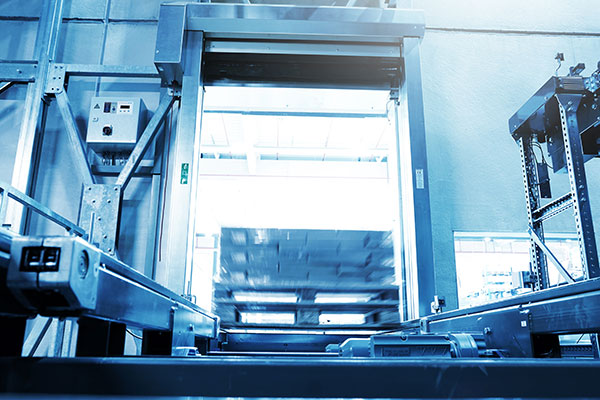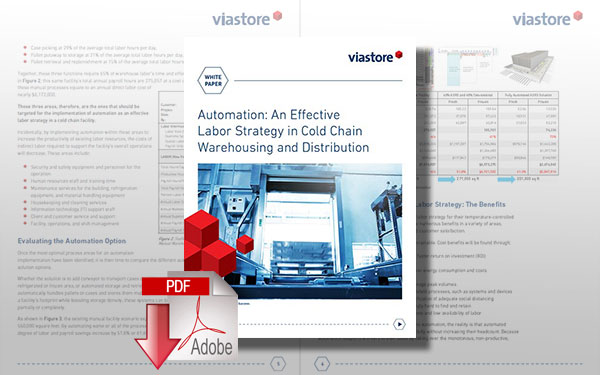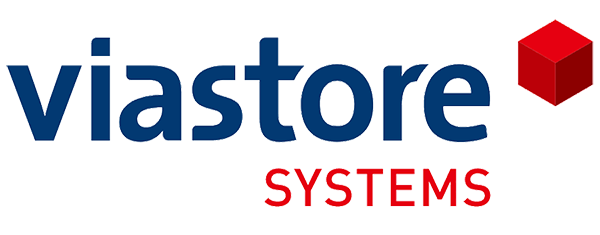Best Practices for a Successful Cold Storage Automation Implementation
With many economists predicting that the extremely low pre-pandemic unemployment rates will continue once the world reaches the “new normal” of the post-pandemic, warehousing and distribution operators are looking for alternatives.
Automation as a Cold Chain Labor Strategy
It was already a challenge to hire and retain associates before COVID-19. Most expect that pattern to continue moving forward, what with the highly competitive labor environment in key geographic areas, 75 million Baby Boomers retiring from the workforce, and a lack of interest in warehousing and distribution jobs by younger generations.
These hiring and retention challenges become even more critical in refrigerated and frozen temperature-controlled operations.
For that reason, more companies are turning to automation as an effective labor strategy in their temperature-controlled facilities. But simply signing a contract for an automated solution neither guarantees a successful deployment nor reliable, consistent performance.
To help operators considering implementing an automated solution in their cold storage facility, a recent viastore webinar included insights from two front line experts. Joel Marpe of Walmart and Dan Cahill of C&W Services have more than 35 years combined expertise in designing, specifying, installing, and commissioning automated systems for large-scale, multi-location cold chain facilities in both retail and wholesale grocery.
Marpe spent more than 20 years at Walmart, leading operations teams as a Divisional Vice President and running corporate logistics as Vice President of Logistics Administration. During his tenure, Marpe led teams implementing value-engineered solutions in more than 100 distribution centers (DCs) across multiple networks.
Projects included the mechanization and automation of 10 large frozen and refrigerated DCs with automated storage and retrieval systems (ASRS); implementation and operation of a fully automated food distribution center; and management of a budget of more than $1 billion.
Cahill has held supply chain positions with Schreiber Foods, Kroger, and C&W Services for more than 15 years. His responsibilities include shaping the direction, development, deployment, and optimization of cutting-edge operational investments, automation solutions, and corporate automation strategy.
With a primary focus on operational change — coupled with a deep understanding of distribution center operations, network design, automation design, and data analytics — Cahill has led the development and successful implementation of novel approaches to optimize DC operations across multiple organizations.
Based on their own vast experiences on the front lines of temperature-controlled automation installations, the following are Marpe and Cahill’s best practice recommendations for a successful cold storage automation implementation.
1. Gain buy-in from the workforce
There is likely to be some resistance from the current workforce to the idea of an automated solution being deployed within the operation. Some may be wary of change, others fearful for their employment status.
To overcome these concerns, it’s important to engage team members from the floor level (not just managers or supervisors) during the design of the system and its integration into the facility’s processes. Giving associates a seat at the table is one of the easiest ways to gain buy-in for the automation project across the entire workforce.
Additionally, if cost savings are an anticipated outcome of the automation implementation, the company should strongly consider sharing those gains with employees. Funds could be distributed through an incentive program, for example. As workers become more accustomed to the new system and process, incentivizing their performance will encourage greater motivation to become a more engaged, productive, safe and committed workforce.
2. Don’t abandon safety programs and continuous training
It would be a mistake to think that adding partial or full automation to an operation eliminates the need for workforce safety programs and ongoing training. Rather, these programs may actually need to become more comprehensive due to the nature of the machinery and equipment involved in an automated system.
Although such an implementation will likely boost productivity without increasing headcount — as well as making associates’ tasks more ergonomic and less labor intensive — maintaining a safe operation is still of paramount importance.
Be sure to assess the current safety and training programming, then determine how they need to evolve. Adding automation to a facility, coupled with a robust safety program, should have a positive impact on the safety metrics of the operation.
3. Leverage the right leadership to minimize startup challenges
Often, companies adding automation to an existing facility elect to retain their current leadership for management of the new operation. However, the addition of automation generally shifts managers’ and supervisors’ focus from guiding and overseeing teams of people to ensuring overall systems and processes are performing as expected. Not every manager or supervisor, however, can easily make the switch without additional support and training.
That’s because the transition from managing people to managing the business requires a different set of skills. It also calls for a more technical, less relational approach plus greater process-level understanding. Be sure the leadership team tasked with executing the startup, deployment, and continuous operation of the new automated system has the opportunity to attain the additional technical leadership skills required of their new roles in order to minimize operational challenges.
4. Solidify a clear functional specification prior to going live
Most automation projects hit a stumbling block at the point of commissioning due to a functional specification that was not clear enough. To avoid a major obstacle or delay at go-live, it’s important to create a comprehensive functional specification that is agreed upon by both the supplier and the company purchasing the equipment.
This document should detail how the system is expected to respond normally, as well as how it will deal with exceptions. Both of those factors should be baked into the testing phase, ensuring that every aspect of the functional specification is verified (and re-verified) during commissioning to confirm that the system operates as expected.
The specification should also delineate the management and governance of the system’s performance during testing and after going live to eliminate confusion and finger pointing.
5. Help your workforce adjust to the new automation with training
As a general rule, the knowledge level of the workforce will have to change when transitioning from a manual environment to an automated operation. For example, the skill sets of existing maintenance teams will need to incorporate the ability to troubleshoot and resolve issues in different types of equipment than they worked with before.
Additionally, warehouse associates’ problem-solving skills will need to evolve from being able to physically track down a missing asset or product to understanding and interpreting the information provided by the automated system about an error or exception.
The best way to quickly bring employees up to speed and ensure their confidence working in the new, automated environment is to develop a robust training program. Proper training will ideally educate the workforce about how the system is supposed to behave, what processes have changed and why, and how to navigate the equipment and its controls. An emphasis on training early and often will help the majority of the workforce to learn, adjust and thrive inside the new automated environment.
6. Build a highly skilled technical and maintenance team
The technical troubleshooting, maintenance, and repair skillset needed for automation varies by the type and complexity of the system being installed. Regardless, it is crucial to build a highly skilled onsite technical team to maintain and service the systems, or to partner with the original equipment manufacturer (OEM) or an authorized third-party service provider who has the technical expertise to maintain the equipment.
Even if in-house technicians will be supported by the OEM or a third-party, they should still complete pre-startup training and participate in some or all of the installation and commissioning phase. This will help to enhance their equipment-specific knowledge and expertise.
Skilled technicians capable of and qualified to work on automated material handling equipment are in high demand and can therefore be difficult to recruit, hire, and retain. However, automated systems that aren’t maintained —especially highly complex ones — can degrade very quickly, resulting in compromised efficiency and significantly reduced throughputs.
Therefore, it is critical to have those technical resources available. Be prepared for high labor costs and the likelihood that these imperative staffers are probably already employed. Further, once you’ve hired these technicians, be aware that other operations will likely attempt to lure them away as long as their numbers remain limited.
7. Nurture a strong, collaborative relationship with the OEM
Automated systems are big investments. They also tend to last a long time; 20 to 30 years of operation is not unusual. For those reasons, it’s important to maintain a strong, positive partnership with the automation equipment’s OEM.
After all, this is the supplier an organization will rely on for system upgrades, expansions, spare parts, and technical support. Find a supplier who is willing to invest time in the project after the go-live process is complete.
Further, an OEM-operation relationship can yield value for both sides through collaboration. By working together, the two sides can more easily identify continuous improvement opportunities in operational processes as supported by the technology.
OEMs have deep knowledge in the design of their technologies, but less real-life operating experience. In a true partnership, both sides work together to learn from each other and make each stronger and better.
Looking to build a more collaborative partnership for your next cold storage warehousing or distribution automation project? viastore provides integrated systems to operations across a broad range of industries, including cold and temperature-controlled facilities.
Our solutions can help you achieve shorter throughput times, higher efficiency and processing reliability, reduced inventory, increased picking speeds and improved customer order quality.
Related White Paper
Automation: An Effective Labor Strategy in Cold Chain Warehousing and Distribution
While many workers fear their jobs will be lost to automation, the reality is that automated solutions enable operations to increase productivity without increasing their headcount. Download Now!
Article Topics
viastore systems News & Resources
Updating Existing Warehouse Equipment and Software Can Mitigate Today’s Fulfillment Challenges Turning Existing Warehouses into Efficient, Optimized Fulfillment Machines Automation as a Cold Chain Labor Strategy Best Practices for a Successful Cold Storage Automation Implementation Automation: An Effective Labor Strategy in Cold Chain Warehousing and Distribution AS/RS Modernization Reduces Downtime and Saves Thousands of Dollars at Food Service Facility Automation Considerations for Frozen Product Storage More viastore systemsLatest in Warehouse|DC
U.S. Manufacturing is Growing but Employment Not Keeping Pace Maximize Warehouse Space with Mezzanine Automation: Expert Tips Most Companies Unprepared For Supply Chain Emergency Microsoft Unveils New AI Innovations For Warehouses Spotlight Startup: Cart.com is Reimagining Logistics Walmart and Swisslog Expand Partnership with New Texas Facility Taking Stock of Today’s Robotics Market and What the Future Holds More Warehouse|DC














